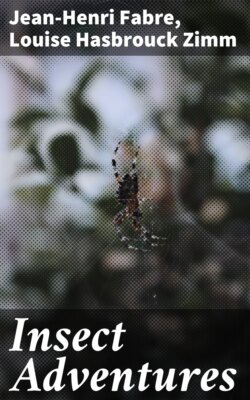Читать книгу Insect Adventures - Fabre Jean-Henri - Страница 11
На сайте Литреса книга снята с продажи.
SOME USEFUL VISITORS OF THE BEES
ОглавлениеTable of Contents
I have told you about the robber Stelis-wasp who enters the Bee’s cement house and steals the provisions laid up for the Bee-baby; she is not the only one who despoils the poor Mason-bee. There is another Bee, the Dioxys, who acts in about the same way as the Stelis-wasp, except that she sometimes does even worse, and eats up the grub itself, as well as its honey. Then there are the Osmia-bees and the Leaf-cutting Bees, who make themselves very much at home in the Bees’ houses, when they get a chance, keeping out the real owners; and there are also three flies, whose grubs eat the Bee-grub alive! It sometimes seems wonderful that the Mason-bee should ever live to grow up; and you will be glad to hear of three other visitors the Bee-grub has, which actually help instead of making it impossible for it to live. These are three Beetles.
The old nests which the Mason-bees build in, to save themselves the trouble of making new ones, are often in a very insanitary condition. The cells are full of dead larvæ (larva is another word for grub, and both words mean the first stage of the insect after leaving the egg, when it looks like a little worm), which, for some reason or other, could not break through their hard prisons; of honey which has not been eaten and has turned sour; of tattered cocoons, and shreds of skin, left behind when the grubs turned into Bees. All these dead and useless things are, of course, not pleasant to have in any house, especially in a tidy Bee’s.
Here is where the Beetles come to the rescue. They enter the Bee’s house and lay their eggs there. The larvæ, when they come out of the eggs, begin to make themselves useful. Two species of larvæ gnaw the remains of the dead Bees; the third, which is quite a good-looking worm, with a black head and the rest of its body a pretty pink, takes care of the spoiled honey. This worm turns into a Beetle in a red dress with blue ornaments, whom you may often see strolling about the Bee’s house in the working season, tasting here and there drops of honey oozing from some cracked cell. The Bees leave him in peace, as if they knew that it was his duty to keep their house wholesome.
Still later, when the Bee’s house, exposed as it is to wind and weather, cracks and falls to pieces almost entirely, the Bees leave it for good and all, and still other insects take possession of it. These are gypsies, who are not particular where they camp out. Spiders make their homes in the blind alleys which used to be cells, and weave white-satin screens, behind which they lie in wait for passing game. The Hunting-wasps arrange nooks with earthen embankments or clay partitions, and there store up small members of the Spider tribe as food for their families. So we see that the house that the Mason-bee built for herself is useful to many others, good, bad, or indifferent friends of hers as the case may be.
